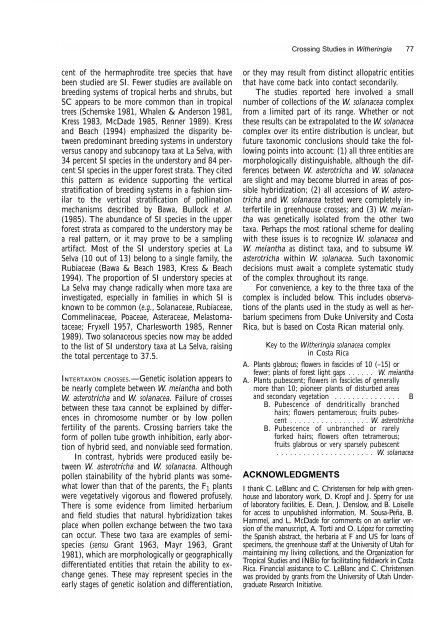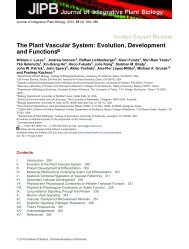Insights into the Witheringia solanacea (Solanaceae ... - BioOne
Insights into the Witheringia solanacea (Solanaceae ... - BioOne
Insights into the Witheringia solanacea (Solanaceae ... - BioOne
You also want an ePaper? Increase the reach of your titles
YUMPU automatically turns print PDFs into web optimized ePapers that Google loves.
cent of <strong>the</strong> hermaphrodite tree species that have<br />
been studied are SI. Fewer studies are available on<br />
breeding systems of tropical herbs and shrubs, but<br />
SC appears to be more common than in tropical<br />
trees (Schemske 1981, Whalen & Anderson 1981,<br />
Kress 1983, McDade 1985, Renner 1989). Kress<br />
and Beach (1994) emphasized <strong>the</strong> disparity between<br />
predominant breeding systems in understory<br />
versus canopy and subcanopy taxa at La Selva, with<br />
34 percent SI species in <strong>the</strong> understory and 84 percent<br />
SI species in <strong>the</strong> upper forest strata. They cited<br />
this pattern as evidence supporting <strong>the</strong> vertical<br />
stratification of breeding systems in a fashion similar<br />
to <strong>the</strong> vertical stratification of pollination<br />
mechanisms described by Bawa, Bullock et al.<br />
(1985). The abundance of SI species in <strong>the</strong> upper<br />
forest strata as compared to <strong>the</strong> understory may be<br />
a real pattern, or it may prove to be a sampling<br />
artifact. Most of <strong>the</strong> SI understory species at La<br />
Selva (10 out of 13) belong to a single family, <strong>the</strong><br />
Rubiaceae (Bawa & Beach 1983, Kress & Beach<br />
1994). The proportion of SI understory species at<br />
La Selva may change radically when more taxa are<br />
investigated, especially in families in which SI is<br />
known to be common (e.g., <strong>Solanaceae</strong>, Rubiaceae,<br />
Commelinaceae, Poaceae, Asteraceae, Melastomataceae;<br />
Fryxell 1957, Charlesworth 1985, Renner<br />
1989). Two solanaceous species now may be added<br />
to <strong>the</strong> list of SI understory taxa at La Selva, raising<br />
<strong>the</strong> total percentage to 37.5.<br />
INTERTAXON CROSSES.—Genetic isolation appears to<br />
be nearly complete between W. meiantha and both<br />
W. asterotricha and W. <strong>solanacea</strong>. Failure of crosses<br />
between <strong>the</strong>se taxa cannot be explained by differences<br />
in chromosome number or by low pollen<br />
fertility of <strong>the</strong> parents. Crossing barriers take <strong>the</strong><br />
form of pollen tube growth inhibition, early abortion<br />
of hybrid seed, and nonviable seed formation.<br />
In contrast, hybrids were produced easily between<br />
W. asterotricha and W. <strong>solanacea</strong>. Although<br />
pollen stainability of <strong>the</strong> hybrid plants was somewhat<br />
lower than that of <strong>the</strong> parents, <strong>the</strong> F 1 plants<br />
were vegetatively vigorous and flowered profusely.<br />
There is some evidence from limited herbarium<br />
and field studies that natural hybridization takes<br />
place when pollen exchange between <strong>the</strong> two taxa<br />
can occur. These two taxa are examples of semispecies<br />
(sensu Grant 1963, Mayr 1963, Grant<br />
1981), which are morphologically or geographically<br />
differentiated entities that retain <strong>the</strong> ability to exchange<br />
genes. These may represent species in <strong>the</strong><br />
early stages of genetic isolation and differentiation,<br />
Crossing Studies in Wi<strong>the</strong>ringia 77<br />
or <strong>the</strong>y may result from distinct allopatric entities<br />
that have come back <strong>into</strong> contact secondarily.<br />
The studies reported here involved a small<br />
number of collections of <strong>the</strong> W. <strong>solanacea</strong> complex<br />
from a limited part of its range. Whe<strong>the</strong>r or not<br />
<strong>the</strong>se results can be extrapolated to <strong>the</strong> W. <strong>solanacea</strong><br />
complex over its entire distribution is unclear, but<br />
future taxonomic conclusions should take <strong>the</strong> following<br />
points <strong>into</strong> account: (1) all three entities are<br />
morphologically distinguishable, although <strong>the</strong> differences<br />
between W. asterotricha and W. <strong>solanacea</strong><br />
are slight and may become blurred in areas of possible<br />
hybridization; (2) all accessions of W. asterotricha<br />
and W. <strong>solanacea</strong> tested were completely interfertile<br />
in greenhouse crosses; and (3) W. meiantha<br />
was genetically isolated from <strong>the</strong> o<strong>the</strong>r two<br />
taxa. Perhaps <strong>the</strong> most rational scheme for dealing<br />
with <strong>the</strong>se issues is to recognize W. <strong>solanacea</strong> and<br />
W. meiantha as distinct taxa, and to subsume W.<br />
asterotricha within W. <strong>solanacea</strong>. Such taxonomic<br />
decisions must await a complete systematic study<br />
of <strong>the</strong> complex throughout its range.<br />
For convenience, a key to <strong>the</strong> three taxa of <strong>the</strong><br />
complex is included below. This includes observations<br />
of <strong>the</strong> plants used in <strong>the</strong> study as well as herbarium<br />
specimens from Duke University and Costa<br />
Rica, but is based on Costa Rican material only.<br />
Key to <strong>the</strong> Wi<strong>the</strong>ringia <strong>solanacea</strong> complex<br />
in Costa Rica<br />
A. Plants glabrous; flowers in fascicles of 10 (–15) or<br />
fewer; plants of forest light gaps ...... W. meiantha<br />
A. Plants pubescent; flowers in fascicles of generally<br />
more than 10; pioneer plants of disturbed areas<br />
and secondary vegetation ............... B<br />
B. Pubescence of dendritically branched<br />
hairs; flowers pentamerous; fruits pubescent<br />
..................W. asterotricha<br />
B. Pubescence of unbranched or rarely<br />
forked hairs; flowers often tetramerous;<br />
fruits glabrous or very sparsely pubescent<br />
...................... W. <strong>solanacea</strong><br />
ACKNOWLEDGMENTS<br />
I thank C. LeBlanc and C. Christensen for help with greenhouse<br />
and laboratory work, D. Kropf and J. Sperry for use<br />
of laboratory facilities, E. Dean, J. Denslow, and B. Loiselle<br />
for access to unpublished information, M. Sousa-Peña, B.<br />
Hammel, and L. McDade for comments on an earlier version<br />
of <strong>the</strong> manuscript, A. Torti and O. López for correcting<br />
<strong>the</strong> Spanish abstract, <strong>the</strong> herbaria at F and US for loans of<br />
specimens, <strong>the</strong> greenhouse staff at <strong>the</strong> University of Utah for<br />
maintaining my living collections, and <strong>the</strong> Organization for<br />
Tropical Studies and INBio for facilitating fieldwork in Costa<br />
Rica. Financial assistance to C. LeBlanc and C. Christensen<br />
was provided by grants from <strong>the</strong> University of Utah Undergraduate<br />
Research Initiative.
















